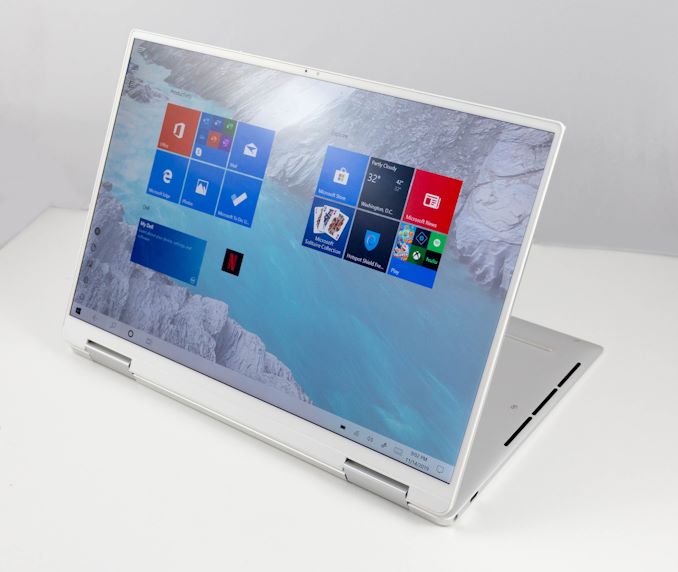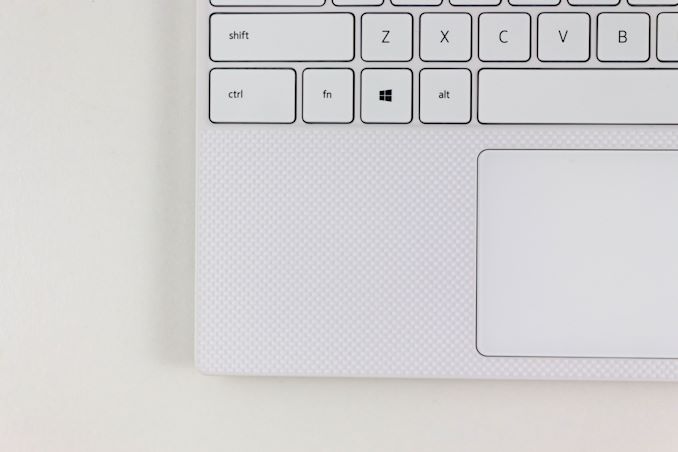The Dell XPS 13 7390 2-in-1 Review: The Ice Lake Cometh
by Brett Howse on November 15, 2019 11:30 AM ESTDesign
The latest generation XPS 13 2-in-1 is a stunner. Dell has tweaked the design in all the right areas to create one of the best looking laptops in its class, and it starts with the CNC aluminum chassis. While somehow thinner and lighter than ever, the new design still feels very sturdy. Even with the body ranging from just 7 mm to 11 mm in thickness, there’s very little flex in the chassis at all, even with the laptop open. The silver finish on the outside offers a nice texture while being resistant to fingerprints. And even though this is a 2-in-1 laptop, it still only weighs 1.32 kg / 2.9 lbs.
Dell offers two color choices, providing a small bit of personalization that many will appreciate, but the choices only apply to the interior, where you can opt for the more traditional black with the carbon fiber composite keyboard deck, or you can choose an arctic white interior which features a woven glass fiber with a titanium oxide coating to provide a pearlescent sheen, as well as UV protection to prevent yellowing of the color over time, and stain resistance as well. The arctic white looks and feels stunning, with a great texture for your wrists to rest on, although with a negative we will get to in a moment.
Opening the laptop is a joy, thanks to a variable torque hinge, which gets progressively tighter as the display opens, which allows the laptop to be opened easily, yet still be usable with touch. The hinge rotates and progressively raises the back of the laptop up, which is something that several laptops do that is not great for ergonomics, but the lift is subtle enough that it is not a big issue. Dell has also smartly added rubber pads to the hinge, so when it lifts the rear of the laptop up, it maintains a firm grip on the desk, eliminating one of the biggest issues with this design.
The display area is wonderfully large, and with Dell moving to a 16:10 aspect ratio, the taller display eliminates the large chin seen on many competitors laptops. The thin bezels house a tiny 4-element webcam in the correct location, and although it is just a 720p webcam, Dell is utilizing temporal noise reduction to improve video quality by using multiple frames concurrently to remove graining and noise from the video.
Dell has outfitted the XPS 13 7390 2-in-1 with their second generation MagLev keyboard, and if there was a weak point so far, this would be it. Dell has done this to save space – the MagLev keyboard is 24% thinner than a typical keyboard, and Dell has tuned it to be quieter and softer than before. But the extreme thinness means that there is just not a lot of keyboard travel, and typing on this will take some getting used to. It also means that Dell has flattened out the keys, so touch typists may be caught off-guard by the lack of any kind of contour.
Dell has also placed the power key in the keyboard, which isn’t ideal for a 2-in-1 device, and meaning the fingerprint reader may not be in a suitable location when using the laptop. It also means you could accidently turn the laptop off when typing, but Dell is far from being the only one to put the power button here.
Our review unit is the Artic White model, and while the keyboard deck feels great and the white color is wonderful to look at, white keys with white backlighting is never a good combination; so be aware of that if you do prefer the white. The backlighting wipes out all contrast with the keyboard fonts, as it does on almost any light-colored key cap with a white backlight, and even in dim lighting you may want to leave the backlighting off. Luckily it’s not difficult to turn it off and on, but for this reason the black model would be a better functional choice.
PC trackpads have come a long way from the dreary days of old, and Dell offers a signature touchpad on the XPS 13 2-in-1. The surface is extremely smooth glass, offering a great feel and accurate movements. Multiple finger gestures work flawlessly making it easy to switch apps or scroll.
There’s not a lot going on as far as ports, with just two USB-C ports with Thunderbolt 3 support with four lanes of PCIe Gen 3 on each. There’s also a micro SD card slot, and a 3.5 mm headset jack, and that is it. Luckily, that should be enough for most people looking for a smaller 2-in-1 device, and expandability is still available thanks to the TB3.
Dell has made some other nice touches as well. There’s a battery charge indicator bar at the front of the laptop that you can easily see whether the laptop is open or closed, and lets you know at a glance how much battery is charged because the light expands from left to right to show the current charge state, and then turns off completely when the laptop hits 100%. The laser etched logo also works very well with the overall design aesthetic. It is an impressive, modern take on the XPS 13 in 2019, and the added functionality of this being a 2-in-1 adds even more capability.
















108 Comments
View All Comments
ikjadoon - Friday, November 15, 2019 - link
This is actually huge. Huawei & Microsoft couldn't move the 16:9-fanatics alone: I'm glad Dell did this.Lenovo has forsaken their roots with their infatuation with 16:9 in 2019.
Color me surprised that Dell was first to commercialize user feedback into an actual product (i.e,. what Huawei, Microsoft, and Apple have known for the better part of a decade).
ToTTenTranz - Friday, November 15, 2019 - link
Will you guys have the new Spectre 13 X360 with a 4K AMOLED display?It's a heavy competitor to the XPS 13 due to the new chassis with much smaller bezels, and it's also using Ice Lake.
Beltendu - Thursday, November 21, 2019 - link
Really looking forward to this. It's not exactly apples to apples (eg, no 1980x1200 on the Spectre), but similar specs otherwise comes out cheaper. I'd love to know the difference once it's in someone's hands.tipoo - Friday, November 15, 2019 - link
I'm largely left wondering what the heck the whole point of the AMD APU in the Surface Laptop 15 was, they pitched it as the best graphics performance "in this class" (comparing their 15" against the MBP 13"...), and it doesn't even distance itself from Ice Lakes IGP here.danielfranklin - Friday, November 15, 2019 - link
Surely its all about next years model.They didnt have the 7nm and new arch this year, so they worked on the relationship and firmware.
Once AMD can bring them a modern APU, hopefully it will all pay off!
But for this year, CPU barely keeps with with Intel's old CPUs, GPU matches Intel's Icelake. So yeah, pointless right now.
tipoo - Saturday, November 16, 2019 - link
Perhaps. I had been hoping this would be a debut 7nm AMD part, but the 12nm APU leaves me whelmed.Alistair - Friday, November 15, 2019 - link
AMD CPU and GPU is faster for the money. The GPU reviewed here is for the top model, the $1500 model.Alistair - Friday, November 15, 2019 - link
the i3 and i5 models have less than half the speedskavi - Friday, November 15, 2019 - link
The Surface Laptop 3 13.5" uses G7 graphics in the base model, which is $200 less than the base 15".Alistair - Saturday, November 16, 2019 - link
And if you want the 15" with the same processor it is $100 more? You are comparing two different laptops, not just two different processors.